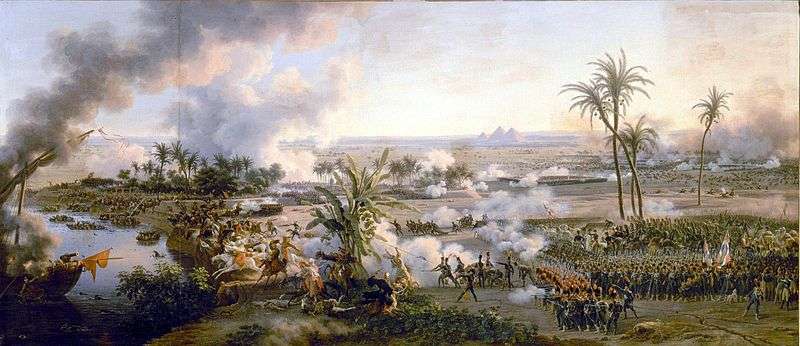Battle of the Pyramids
| Battle of the Pyramids | |||||||
|---|---|---|---|---|---|---|---|
| Part of the Campaign in Egypt and Syria of the French Revolutionary Wars | |||||||
 The Battle of the Pyramids, Louis-François, Baron Lejeune, 1808. | |||||||
| |||||||
| Belligerents | |||||||
|
| |||||||
| Commanders and leaders | |||||||
| Napoleon Bonaparte |
Murad Bey Ibrahim Bey | ||||||
| Strength | |||||||
|
20,000 total 3,000 cavalry 17,000 infantry 42 cannons[1][2] | 25,000[3] | ||||||
| Casualties and losses | |||||||
| 29 dead, 260 wounded[4] |
20,000 Mamelukes from Napoleon's own records[5] or uncertain from other sources Several thousand peasants dead or wounded | ||||||
The Battle of the Pyramids, also known as the Battle of Embabeh, was a major engagement fought on July 21, 1798 during the French Invasion of Egypt. The French army under Napoleon Bonaparte scored a decisive victory against the forces of the local Mamluk rulers, wiping out almost the entire Egyptian army. It was the battle where Napoleon employed one of his significant contributions to military tactics, the divisional square. Actually a rectangle, the deployment of the French brigades into these massive formations repeatedly threw back multiple cavalry charges by the Egyptians.
The victory effectively sealed the French conquest of Egypt as Murad Bey salvaged the remnants of his army, chaotically fleeing to Upper Egypt. French casualties amounted to roughly 300, but Egyptian casualties soared into the thousands. Napoleon entered Cairo after the battle and created a new local administration under his supervision.
The battle exposed the fundamental military and political decline of the Ottoman Empire throughout the past century, especially compared to the rising power of Napoleon's France. Napoleon named the battle after the Egyptian pyramids because they were faintly visible on the horizon when the battle took place.
Prelude

In July 1798, Napoleon was marching from Alexandria toward Cairo after invading and capturing the former. He met the forces of the ruling Mamluks nine miles (15 km) from the Pyramids, and only four miles (6 km) from Cairo. The Mamluk forces were commanded by two Georgian mamluks Murad Bey and Ibrahim Bey and had powerful and highly developed cavalry. This fight was known as The Battle of Chobrakit.
Napoleon realized that the only Egyptian troops of any worth on the battlefield were the cavalry. He exhorted his troops, saying, "Forward! Remember that from those monuments yonder forty centuries look down upon you."[6]
Battle

Napoleon ordered an advance on Murad's army with each of the five divisions of his army organized into hollow rectangles with cavalry and baggage at the center and cannon at the corners.
The French divisions advanced south in echelon, with the right flank leading and the left flank protected by the Nile. From right to left, Napoleon posted the divisions of Louis Charles Antoine Desaix, Jean Reynier, Dugua, Vial and Louis André Bon. In addition, Desaix sent a small detachment to occupy the nearby village of Biktil, just to the west.
Murad anchored his right flank on the Nile at the village of Embabeh, which was fortified and held with infantry and some ancient cannons. His Mamluk cavalry deployed on the desert flank. Ibrahim, with a second army, watched helplessly from the east bank of the Nile, unable to intervene. Chandler asserts that Napoleon's 25,000-strong army outnumbered Murad's 6,000 Mamluks and 15,000 infantry.
At about 3:30 pm, the Mamluk cavalry hurled itself at the French without warning. The divisional squares of Desaix, Reynier and Dugua held firm and repelled the horsemen with point-blank musket and artillery fire. Unable to make an impression on the French formations, some of the frustrated Mamluks rode off to attack Desaix's detached force. This was also a failure.
Meanwhile, nearer the river, Bon's division deployed into attack columns and charged Embabeh. Breaking into the village, the French routed the garrison. Trapped against the river, many of the Mamluks and infantry tried to swim to safety, and hundreds drowned.
Napoleon reported a loss of 29 killed and 260 wounded. Murad's losses were far heavier, perhaps as many as 3,000 of the irreplaceable Mamluk cavalry and unknown numbers of infantry. Murad escaped to Upper Egypt, where he carried on an active guerilla campaign before being run to earth by Desaix in late 1799.
Aftermath
Upon the news of the defeat of their legendary cavalry, the waiting Mamluk armies in Cairo dispersed to Syria to reorganize. The Battle of the Pyramids signalled the beginning of the end of 700 years of Mamluk rule in Egypt. Despite this auspicious beginning, Admiral Horatio Nelson's victory in the Battle of the Nile ten days later ended Napoleon's hopes for a conquest of the Middle East.
Engulfed by the west bank portion of the city of Cairo, nothing remains of the battlefield today.
References
- Notes
- ↑ Smith The Greenhill Napoleonic Wars Data Book. Greenhill Books, 1998. p. 140
- ↑ Connelly. Blundering to Glory: Napoleon’s Military Campaigns. Rowman & Littlefield Pub., 2006. 3rd ed. p.50.
- ↑ NAKOULA EL-TURK. Histoire de l'expédition des français en Égypte par Nakoula El-Turk. Publiée et traduite par M. Desgrandes Aîné.
- ↑ NAKOULA EL-TURK. Histoire de l'expédition des français en Égypte par Nakoula El-Turk. Publiée et traduite par M. Desgrandes Aîné.
- ↑ NAKOULA EL-TURK. Histoire de l'expédition des français en Égypte par Nakoula El-Turk. Publiée et traduite par M. Desgrandes Aîné.
- ↑ The Campaigns of Napoleon, Volume 1, By David G. Chandler; page 224
- Bibliography
- Chandler, David, The Campaigns of Napoleon New York, Macmillan, 1966.
- Cole, Juan, Napoleon's Egypt: Invading the Middle East Palgrave Macmillan, 2007. [ISBN 1403964319]
- Herold, J. Christopher, Bonaparte in Egypt - London, Hamish Hamilton, 1962.
- Herold, J. Christopher, The Age of Napoleon. New York, American Heritage, 1963.
- Moorehead, Alan, The Blue Nile New York, Harper & Row, 1962.